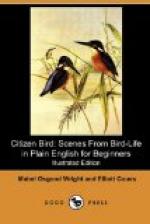“Oh, yes! Everything you can see about a bird has its own name. Those small feathers are called coverts, because they cover over the roots of the rowers. Those on top are the upper coverts; those underneath are the under coverts, or lining of the wings. Now notice those two pretty bands of color across the Sparrow’s wing. You see one band is formed by the tips of the longest coverts, and the other band by the tips of the next longest coverts. Those two rows of feathers are the greater and middle coverts, and all the smallest feathers, next to the front edge of the wing, are called lesser coverts. Now look at the tail, Rap, and tell me what you can find.”
“Why, there is a bunch of long stiff feathers like rowers, that slide over each other when you spread the tail, and a lot of short feathers that hide the roots of the long ones. Are they rowers and coverts too?” “A bird does not row with his tail—he steers with it, as if it were a rudder; and the long feathers are therefore called rudder-feathers—or rectrices, which is Latin for rudders. But the short ones are called coverts, like those of the wings—upper tail-coverts, and under tail-coverts.”
“How funny!” said Dodo, “for a bird to have to row himself and steer himself all at once. I know I should get mixed up if I tried it with a boat. How do feathers grow, Uncle Roy?”
“Just like your hair, little girl,” said the Doctor, patting her on the head, “or your nails. Didn’t you ever notice the dots all over the skin of a chicken? Each dot is a little hole in the skin where a feather sprouts. It grows in a sheath that pushes out of the hole, like a plant coming up out of the ground from its root. For a while this sheath is full of blood to nourish the growing feather; that is why new feathers look dark and feel soft—pin-feathers they are called. The blood dries up when the feather has unfolded to its full size, leaving it light and dry, with a horny part at the root that sticks in the hole where it grew, and a spray-like part that makes up most of the feather. The horny part becomes hollow or contains only a little dry pith; when it is large enough, as in the case of a rowing feather from a Goose’s wing, it makes a quill pen to write with. But the very tiniest feather on this Sparrow is built up in the same way.
“See! here is one,” continued the Doctor, as he twitched out a feather from the Sparrow’s back. “You see the quill part runs in the middle from one end to the other; this is called the shaft. On each side of it all along, except just at the root, the spray-like parts grow. They are called the webs or vanes. Now look through this magnifying glass at the web.”
The children looked in turn, and each, exclaimed in wonder at the sight.
“Yes, it is very wonderful. The web, that looks so smooth to the naked eye, is made up of a great many small shafts, called barbs, that grow out of the main shaft in rows. Every one of these small side-shafts has its own rows of still smaller shafts; and these again have little fringes along their edges, quite curly or like tiny hooks, that catch hold of the next row and hold fast. So the whole feather keeps its shape, though it seems so frail and delicate.”




